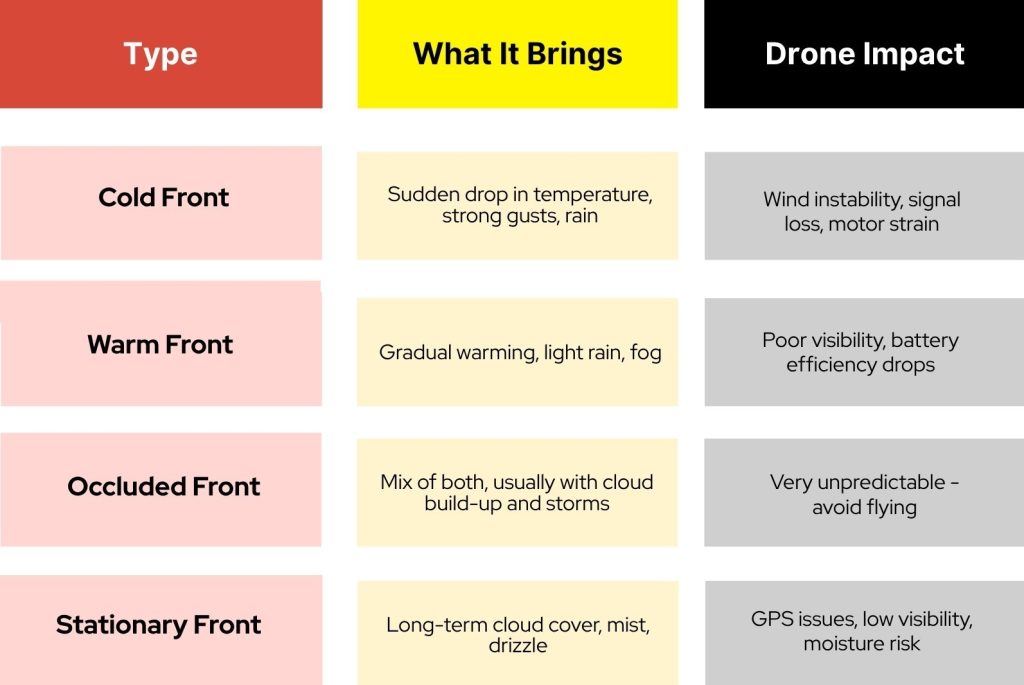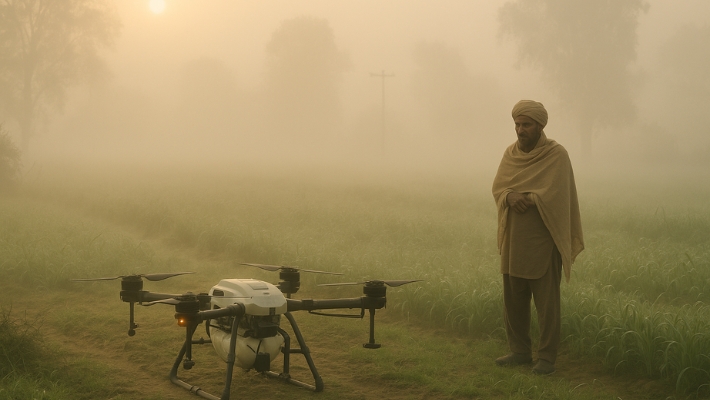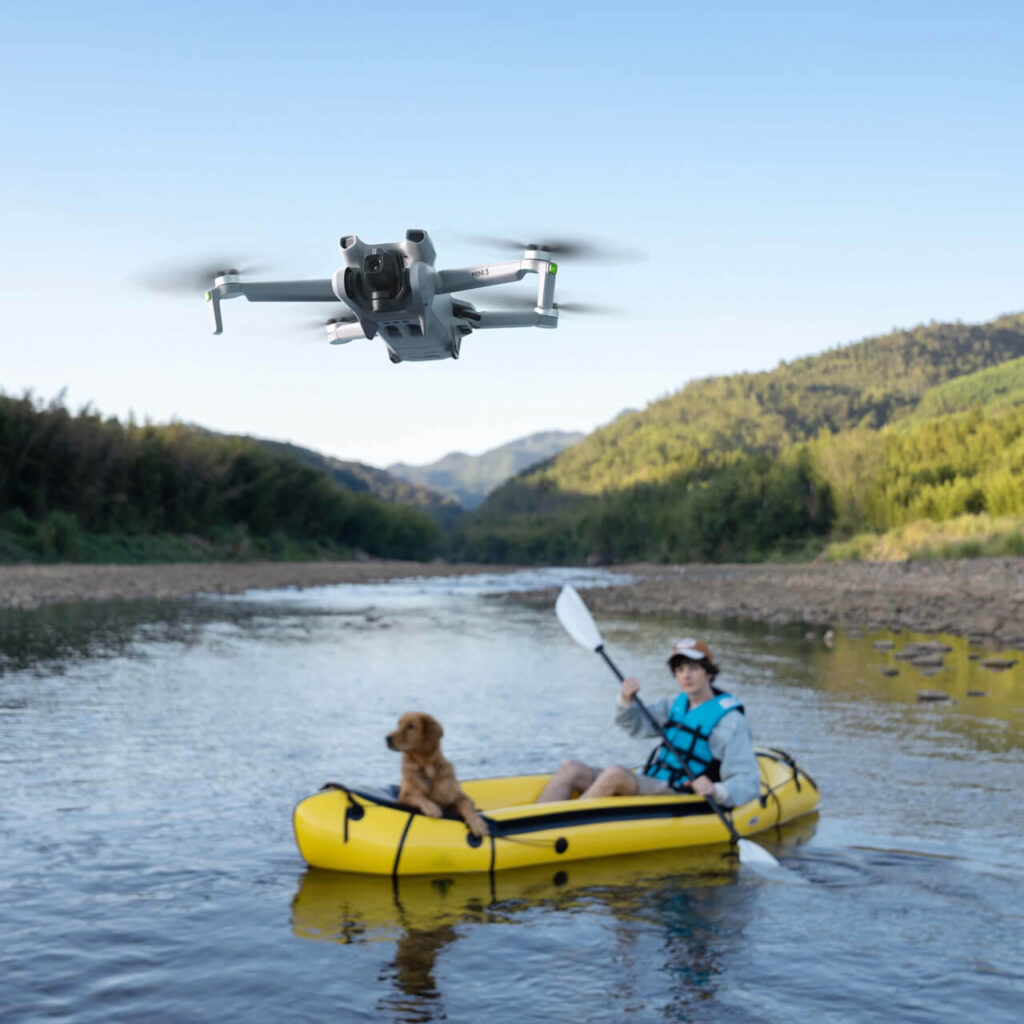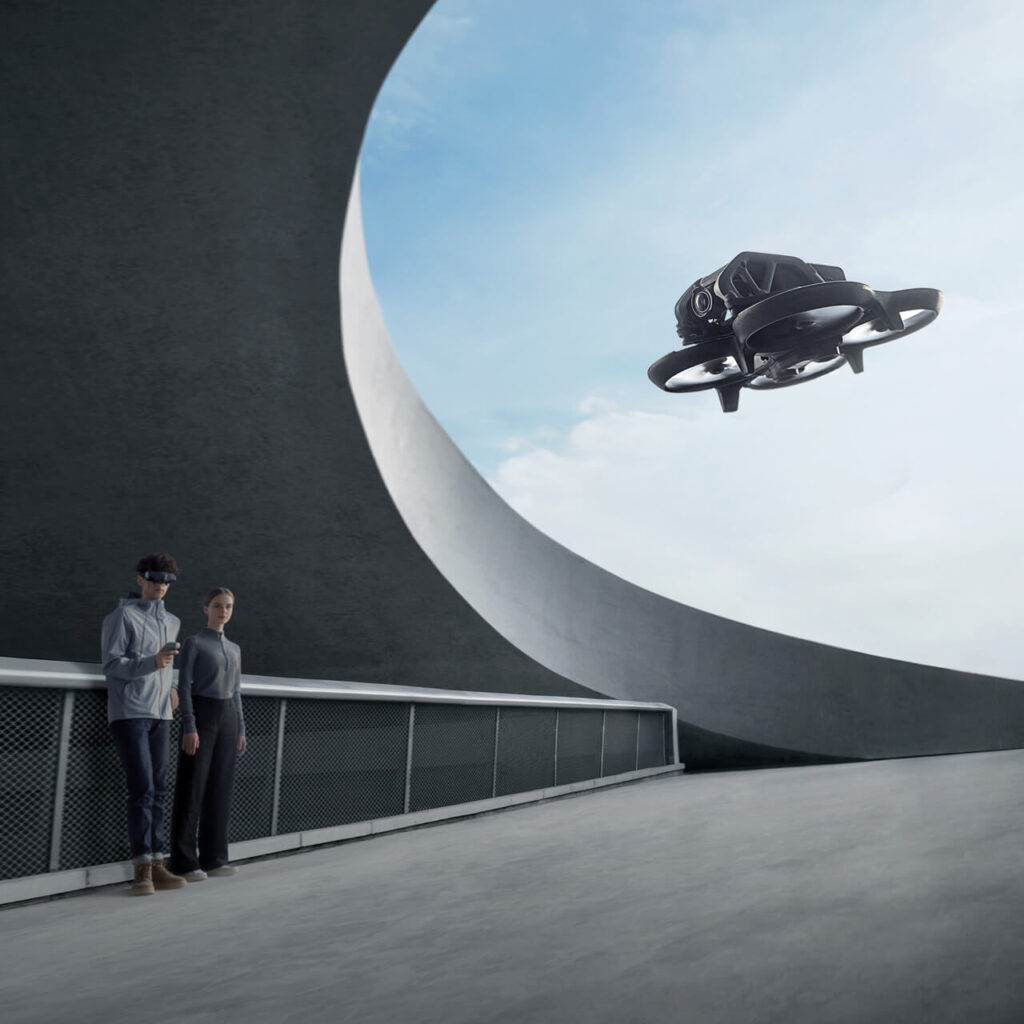Flying a drone isn’t just about GPS lock and camera angles. It’s also about knowing what’s happening in the sky especially when it comes to weather fronts. For drone pilots, understanding these shifting air masses can mean the difference between a smooth mission and a costly crash.
Whether you’re flying for agriculture, mapping, filmmaking, or surveillance, weather fronts can affect wind speed, visibility, temperature, and precipitation all of which directly impact flight safety and drone performance.
Yet, many drone users overlook this critical piece of pre-flight planning. This blog will break down:
- What weather fronts actually are
- How they influence drone operations
- Why recognizing them matters before every flight
- Best practices to avoid weather-related issues
- Tools and tips to plan better missions
Whether you fly a DJI, Autel, IdeaForge, Enzo, Parrot, or Skydio drone, this guide will help you make safer, smarter flight decisions. And if you’re buying your drone from Jetayu Gadgets, knowing how to fly in dynamic weather is just as important as choosing the right model.
What Are Weather Fronts?
Before you fly your drone into the open sky, you need to understand one thing: the weather isn’t just about clear or cloudy. It’s about movement and weather fronts are where this movement happens.
Simple Definition for Drone Pilots
A weather front is the boundary where two different air masses meet like warm air and cold air. This meeting zone causes changes in:
- Temperature
- Wind patterns
- Humidity
- Cloud cover
- Precipitation (rain, snow, fog)
For drone pilots, these changes can happen quickly, sometimes within minutes. That’s why even if the sky looks calm at takeoff, flying near a front can turn dangerous fast.
Types of Weather Fronts You Should Know

Why It Matters for Drone Flights
Even a small DJI Mini 4 Pro, which is known for its excellent wind resistance, can struggle during unexpected shifts in wind or sudden rain caused by a front. If you’re a beginner who just got their Fly More Combo, this knowledge can save your drone.
And if you’re flying in the Himalayas, Western Ghats, or open fields for content creation or agriculture conditions near a weather front can change mid-flight, impacting both safety and video quality.
How Weather Fronts Impact Drone Flights
Even the most advanced drones can’t fight the weather. Weather fronts bring dynamic shifts in the environment that can severely affect your drone’s performance, control, and safety. Here’s how:
1. Wind Gusts and Turbulence
- Cold fronts often trigger sudden gusts, which can destabilize even GPS-locked drones.
- Strong winds lead to motor overload, especially in lightweight drones like the DJI Mini 3.
- Turbulence near fronts can drain the battery faster, reducing total flight time and risking emergency landings.
Tip: If you’re worried about your drone’s safety features, check out our guide:
“Worried About Crashing Your First Drone? Here’s Why DJI’s Safety Features Have Your Back.”
2. Poor Visibility
- Fog and low cloud cover near warm or stationary fronts interfere with obstacle sensors and camera feeds.
- Reduced visibility increases the risk of crashing into buildings, trees, or powerlines.
- Makes visual line of sight (VLOS) flying harder, which is required by law in most areas.
Planning a travel vlog or scenic shoot? Learn how drones shine in conditions when humans can’t:
“Vlogging Your Solo Adventure? Here’s What Only a Drone Can Film.”
3. GPS Signal Interference
- Thick clouds and changing pressure zones affect satellite signals.
- Fronts may cause intermittent GPS loss, leading to unstable hovering or drift.
- This especially impacts mapping, surveying, or autonomous flight modes.
If you’re flying commercially, like on a construction site, this is critical. Learn more in:
“Why Builders Now Trust Drones More Than Ground Teams for Site Surveys.”
4. Battery and Sensor Challenges
- Cold fronts cause temperature drops, reducing battery efficiency mid-air.
- Condensation near warm fronts can fog lenses and gimbals.
- Barometric sensors may give altitude errors, especially on cheaper or older models.
New to content creation with drones? Make sure you’re not missing this:
“Is Buying a Drone Enough to Start My Journey as a Content Creator?”
5. Moisture and Electronics Risk
- Warm and occluded fronts bring high humidity, rain, or snow.
- Even a splash of moisture can damage the motors or gimbal.
- Not all drones are waterproof especially camera UAVs used in filmmaking or events.
Just bought a drone? Double-check it’s not a refurbished one before flying in risky conditions:
“Bought a Drone Recently? Here’s How to Verify If It’s Not Refurbished.”
How to Check for Weather Fronts Before a Drone Flight
Being prepared is half the flight. Knowing where and when a weather front might pass can help you avoid surprises in the sky. Thankfully, you don’t need to be a meteorologist just a smart drone pilot with the right tools.
1. Use Trusted Weather Apps and Tools
Several aviation-friendly weather platforms can help you identify upcoming weather fronts:
- Windy.com – Offers live wind maps, pressure systems, and front tracking.
- AccuWeather or The Weather Channel – Good for hourly breakdowns and radar.
- Drone-specific apps like UAV Forecast or AirMap – Show wind, visibility, and cloud cover by hour.
- IMD (India Meteorological Department) – Useful for regional forecasts, especially during monsoon season.
These tools can help you plan your route and timing, especially when flying in sensitive areas like hill stations, coastal zones, or city rooftops.
2. Learn to Read the Sky
Apart from digital tools, knowing the natural signs of a weather front helps in quick decision-making:
| Sky Sign | What It Might Mean |
|---|---|
| Thickening clouds forming in layers | Warm front approaching |
| Sudden temperature drop + dark clouds | Cold front nearby, expect gusts |
| Calm air with light drizzle | Stationary front |
| Quick shift in wind direction | Likely passage of a frontal zone |
If you’re traveling to shoot natural landscapes or high-altitude vlogs, these clues are crucial for avoiding turbulence and visibility issues.
Planning to film India’s vast beauty by drone? Read:
“Touch the Sky. Capture Your India from the Himalayas to the Sea with Your Drone.”
3. Time Your Flights Smartly
- Avoid early mornings in winter fog near warm fronts can be intense.
- Don’t fly before or after thunderstorms common during cold front movement.
- Mid-morning to early afternoon often offers more stable air conditions, especially inland.
For commercial operators, this timing matters even more when working in dynamic spaces like construction zones or farms.
Learn how drones are changing these industries:
“How Cameras in Drones Are Transforming Construction, Farming, and Filmmaking in 2025.”
Best Practices for Drone Pilots Flying Near Weather Fronts
Flying near weather fronts is risky but manageable if you prepare smartly. Whether you’re a beginner or a seasoned commercial pilot, these best practices will help you reduce the chances of flight failure, equipment damage, or accidents.
1. Always Check Weather Before Takeoff
- Use both general weather apps and drone-specific forecast tools.
- Look at hourly changes, not just daily overviews fronts can shift fast.
- Postpone flights if a cold, warm, or occluded front is predicted within your mission window.
Flying without checking conditions could put even your DJI Mini 4 Pro at risk. If you’re new to drones, this model is known for its ease of use and intelligent safety but it’s still no match for unpredictable weather.
Related: “Buying a Drone for the First Time? The DJI Mini 4 Pro Makes It Easy to Fall in Love with Flying.”
2. Use Drones with Intelligent Flight Features
- Choose drones with return-to-home (RTH), obstacle avoidance, and wind resistance alerts.
- Many DJI models, like the Mini 3 and Mini 4 Pro, come equipped with these built-in features.
- These tools help when visibility drops or when wind speeds pick up unexpectedly mid-flight.
If you’re comparing models for your first or next upgrade, this might help:
“DJI Mini 3 vs. Mini 4 Pro—Which Combo Is Right for You?”
3. Shorten Flight Duration in Unstable Conditions
- Don’t push for maximum flight time when weather is shifting.
- Stick to shorter missions to ensure you have enough battery to return safely.
- This is especially important for long-range operations or FPV flights in open terrain.
If you’re using a Fly More Combo, consider carrying all spare batteries fully charged, but plan to use them cautiously.
More on this: “What Is the DJI Fly More Combo? Is It Worth It in 2025?”
4. Fly Lower, But Safely
- Weather fronts often bring turbulence at higher altitudes.
- Flying closer to the ground reduces wind exposure, but maintain a safe altitude to avoid buildings and trees.
- This matters in cities, forests, and agricultural areas.
Flying low can be a great way to capture cinematic shots especially for YouTubers and solo travelers.
Check out: “Best Drones for YouTubers in 2025: Top Picks for Vlogging, Travel & Cinematic Shots.”
5. Comply with Local Drone Laws
- Weather isn’t the only risk breaking no-fly zone laws can ground your operations permanently.
- Know the flying limits, permitted altitudes, and required clearances in your region.
- If a front forces you off your planned course, your backup route should still be legal.
If you’re unsure whether you need a license or what the flying rules are:
“Can I Fly My Drone Freely or Do I Need a License? Understand the Rules.”
Real-World Examples: How Weather Fronts Disrupted Drone Missions

Weather fronts aren’t theoretical hazards. They’ve affected drone pilots in real-world missions across industries like agriculture, construction, content creation, and public service. Here’s how.
1. Agriculture: Missed Spraying Windows Due to a Warm Front
A farm drone operator in Punjab had scheduled an early morning spray using an autonomous agriculture drone. However, a warm front moved in overnight, creating dense fog and low visibility. The drone’s visual sensors couldn’t detect crops accurately, and the mission had to be rescheduled wasting fuel, time, and workforce coordination.
If you’re in the agri-space, weather impacts aren’t optional. Learn what drones work best for this use case:
“How Agriculture Drones Are Transforming Indian Farms: A Guide to the Top Models in 2025.”
2. Construction: Delayed Survey Due to Cold Front Wind Gusts
A drone survey team working for a commercial builder in Hyderabad launched a flight to inspect rooftop work. A cold front passed through midday, bringing sudden 25–30 km/h wind gusts. The drone experienced unstable flight and failed to complete the 3D mapping. Team had to switch to ground photography and redo the drone mapping the next day.
Today, more site teams rely on drones — but they need to know when not to fly:
“Who’s Really Watching Your Construction Site? In 2025, It Might Be a Drone.”
3. Solo Travel Content: Cloud Front Ruins Cinematic Vlog Shots
A solo traveler documenting her bike journey through the Western Ghats launched a DJI Mini series drone at golden hour. A stationary front had settled in the area, leading to unexpected cloud buildup and mist. Her drone lost GPS intermittently, and footage was too dull to use. The opportunity to capture stunning hill visuals was lost.
Capturing India’s vast beauty requires planning beyond battery life. Explore what’s possible when done right:
“Touch the Sky. Capture Your India from the Himalayas to the Sea with Your Drone.”
4. Commercial Media Shoots: Occluded Front Grounds a Live Event
A drone team prepping for a live outdoor drone show in Amaravati saw an occluded front approaching. The team delayed launch, expecting a gap in cloud cover. Instead, the mix of warm and cold air brought unpredictable gusts and brief showers. The entire drone show had to be postponed.
Large-scale events are increasingly backed by drones — but timing is everything.
See: “Drones Are the New Stealth Force Behind 2025’s Biggest Events.”
Frequently Asked Questions (FAQ)
1. Can I fly my drone if the sky looks clear but there’s a front nearby?
Even if the sky looks clear, flying near a weather front can be risky. Fronts often bring sudden changes in wind, temperature, and visibility. Conditions can shift mid-flight without warning. Always check apps like UAV Forecast or Windy.com before takeoff.
2. What type of drones are best for flying in unpredictable weather?
Look for drones with:
- Wind resistance up to 38 km/h
- Obstacle avoidance sensors
- Real-time weather data overlays
- GPS + GLONASS support
3. I’m a solo traveler and vlogger. Should I avoid monsoon zones completely?
Not necessarily. You can still fly, but you need to plan flights during stable pockets between rain spells and avoid mornings with fog. Use waterproof landing pads and always carry a microfiber cloth to wipe moisture off sensors and lenses.
4. Can changing weather affect drone footage quality?
Absolutely. Sudden fog, low cloud, or poor light caused by a front can:
- Distort colors and reduce sharpness
- Interrupt footage with shake or drift
- Cause underexposure in auto mode
Always do a manual camera settings check before flying near fronts.
5. How do I know if I’m allowed to fly when the weather looks safe but I’m in a new area?
Weather is one factor. You also need to check airspace rules, drone weight category, and licensing. Some areas have no-fly zones even in perfect weather.



